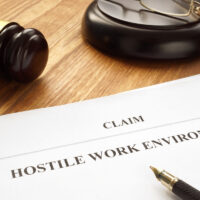How to Know if You are in a Hostile Work Environment

Discrimination, retaliation, harassment, or other signs of a hostile work environment may not be as readily apparent as you might think. Most of us are conditioned to ignore confrontation and go with the flow, downplaying slights made against us. You may not realize that behavior that is actively harming your work life or your career, or that is generally making you uncomfortable, is, in fact, against the law. On the other hand, simply having an unpleasant boss, dealing with a rude coworker, or being overlooked for a promotion may not rise to the level of an actionable hostile work environment. Continue reading for how to prove a hostile work environment, and contact an experienced California labor and employment lawyer with any questions.
The legal requirements for a hostile work environment
Being teased or excluded by your coworkers or boss may be rude, unprofessional, and a fireable offense, but it may not rise to the level of a hostile work environment under federal or California employment law. Likewise, someone simply being an obnoxious and inconsiderate coworker is likely not committing illegal harassment or discrimination. There are specific legal thresholds that must be satisfied in order to bring a claim based on a hostile work environment.
A hostile work environment is created by a boss or coworker whose actions, communications, or behavior make doing your job impossible. The behavior must have altered the terms, conditions, or reasonable expectations of the work environment. Moreover, the behavior must be discriminatory in nature, implicating some category protected by the Equal Employment Opportunity Commission (EEOC) or Department of Fair Employment and Housing (DFEH) such as age, race, nationality, gender, sexual orientation, or disability.
The legal requirements of a hostile work environment include:
- The behavior is discriminatory.
- A reasonable person would find your work environment hostile or abusive.
Severe or pervasive. The more severe the conduct is, the less it must be pervasive, and vice versa:
- The conduct has become pervasive and long-lasting. One-off comments do not usually constitute a hostile work environment, although they should be reported to HR.
- The behavior must be severe. The victim’s desire or ability to work must have been seriously disrupted, or the work environment must interfere with an employee’s career progress.
- The employer knew or had reason to know about the hostile behavior and has not taken steps to either investigate or intervene to correct it.
Examples of a hostile work environment
Your situation may constitute actionable harassment if you have experienced any of the following:
- Discussions of sexual acts, sexually suggestive language, or inappropriate gestures
- Suggestions that you will advance your career if you date or have sex with your supervisor
- Offensive jokes about a protected category of people
- Uninvited comments on physical characteristics
- Unwanted touching
- A co-worker displays racist or sexually-suggestive pictures
- Use of slurs or other offensive language
- Sabotaging of an employee’s work or career
If you have experienced any of the above, or if you have witnessed someone else experiencing this behavior in your workplace, then there may indeed be a hostile workplace and appropriate steps should be taken.
Prevent and Correct Hostile Work Environments in the Bay Area
If you are a San Francisco employer or employee needing personal assistance navigating the current rules on hostile work environments, revising company policies, or pursuing a discrimination claim, contact the Richard Koss Bay Area employment law attorneys at 650-722-7046 on the San Francisco Peninsula, or 925-757-1700 in the East Bay.


